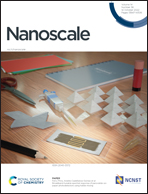High performance printed organic electrochromic devices based on an optimized UV curable solid-state electrolyte†
Abstract
Manufacturing cost is a major concern for electrochromic device (ECD) applications in smart windows for energy saving and low-carbon economy. Fully printing instead of a vacuum-based chemical vapor deposition (CVD) process is favored for large-scale fabrication of ECDs. To adapt to the screen printing process, a UV curable solid-state electrolyte based on lithium bis(trifluoromethane-sulfonyl) imide (LiTFSI) was specially formulated. It contains poly(ethylene glycol) diacrylate (PEG-DA), LiTFSI, water, and ethyl acetate. The optimized ECDs have achieved a 0.6 s bleaching time at 0.6 V and a 1.4 s coloring time at −0.5 V. The ECDs also exhibited excellent stability, which could endure 100 000 cycles of color switching while still maintaining 35% of transmittance change at a 550 nm wavelength. A demo ECD has been fabricated with a screen printed electrolyte, exhibiting stable switching between the clear state and patterned color state.

- This article is part of the themed collection: Nanomaterials for printed electronics


 Please wait while we load your content...
Please wait while we load your content...